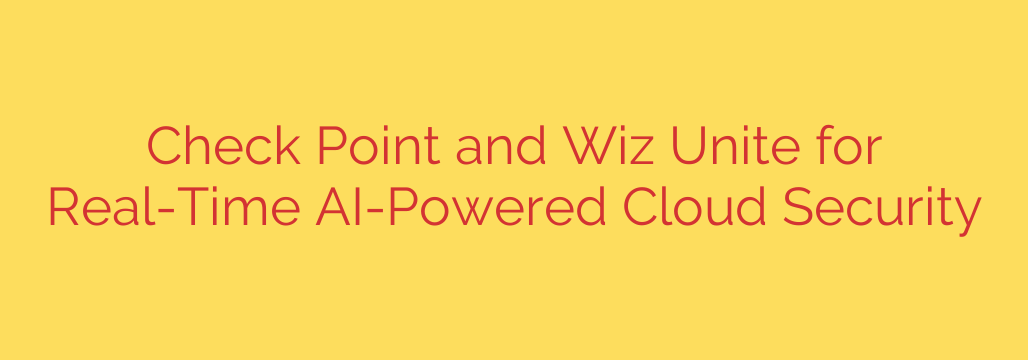
Unifying Cloud Security: How AI is Closing the Gap Between Detection and Prevention
Navigating the complexities of modern cloud security can feel like trying to solve a puzzle with pieces from different boxes. Security teams are often equipped with powerful tools for detecting vulnerabilities and misconfigurations, but a separate set of tools is required to actually prevent attacks. This gap between detection and prevention creates a critical window of opportunity for attackers. A new, integrated approach powered by AI is emerging to close this gap, promising a future of real-time, proactive cloud defense.
The core challenge lies in a fragmented security landscape. While one system might excel at scanning your cloud environment and identifying potential risks, it often stops there, generating a long list of alerts. It then falls to an overworked security team to manually investigate, prioritize, and use another tool to implement a fix or a protective measure. This process is slow, inefficient, and prone to human error.
In this high-stakes environment, alert fatigue is a serious threat. When security professionals are bombarded with thousands of low-context notifications, they risk missing the one critical warning that signals an imminent breach. The key isn’t just to find more problems, but to find the right problems and fix them instantly.
A Powerful New Collaboration in Cloud Security
To address this fundamental disconnect, a groundbreaking collaboration between security leaders Check Point and Wiz is setting a new standard for what a comprehensive cloud security platform can achieve. By integrating Check Point’s CloudGuard threat prevention capabilities with Wiz’s powerful cloud-native visibility, organizations can now move from simply identifying risks to actively preventing their exploitation in real time.
This integration creates a single, unified source of truth for cloud security, enabling a seamless workflow from discovery to defense. It represents a significant shift from a reactive posture to a proactive, prevention-first strategy.
Key Benefits of an AI-Powered, Integrated Security Platform
This unified approach delivers several transformative advantages for organizations looking to secure their cloud assets effectively.
Real-Time, Automated Prevention: The most significant benefit is the ability to act on intelligence instantly. When the integrated platform detects a critical vulnerability or an active threat, it can automatically deploy a virtual patch or a security policy to block the attack vector. This means a critical risk can be neutralized in seconds, before it can be exploited, without requiring any manual intervention.
Context-Rich Prioritization: Not all vulnerabilities pose the same level of risk. An exposed database with sensitive data is far more critical than a minor misconfiguration on a non-critical development server. By combining deep visibility into the cloud environment with advanced threat intelligence, the platform provides the crucial context needed to prioritize the most significant threats. This allows security teams to focus their energy where it matters most, dramatically improving efficiency.
Comprehensive Code-to-Cloud Security: True cloud-native security isn’t just about what’s running in production. It starts the moment a developer writes the first line of code. This integrated solution provides full coverage across the entire application lifecycle, from development to deployment and runtime. By embedding security into the CI/CD pipeline and protecting running workloads, it ensures that applications are secure from start to finish.
Simplified Operations and Reduced Fatigue: By consolidating visibility and prevention into a single framework, organizations can streamline their security operations. Instead of juggling multiple dashboards and manually correlating alerts, teams get a clear, actionable view of their security posture. The alerts they receive are fewer, smarter, and directly linked to preventative actions, freeing up valuable time and resources.
Actionable Steps to Strengthen Your Cloud Security
While advanced tools provide a powerful foundation, a strong security posture also depends on sound strategy. Here are a few actionable tips for your organization:
- Audit Your Security Stack: Evaluate your current security tools. Is there a significant gap between your detection and prevention capabilities? Look for opportunities to integrate your systems to create automated workflows.
- Focus on Context, Not Just Count: Shift your team’s mindset from simply counting vulnerabilities to understanding their business impact. Prioritize risks based on factors like data sensitivity, network exposure, and exploitability.
- Leverage Automation: Identify high-confidence security events and create automated response playbooks. Whether it’s isolating a compromised workload or applying a virtual patch, automation is your best defense against fast-moving threats.
- Embrace a Prevention-First Mindset: The ultimate goal is to stop attacks before they happen. Invest in technologies and processes that proactively reduce your attack surface and block threats in real time, rather than relying solely on your ability to react to a breach.
The future of cloud security is intelligent, integrated, and automated. By bridging the critical gap between seeing a problem and solving it, this new generation of AI-powered platforms is empowering organizations to move faster, reduce risk, and confidently innovate in the cloud.
Source: https://datacenternews.asia/story/check-point-wiz-unveil-unified-cloud-security-with-real-time-ai








